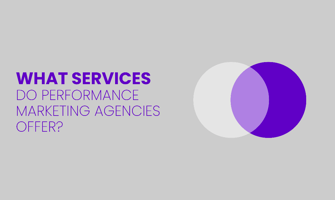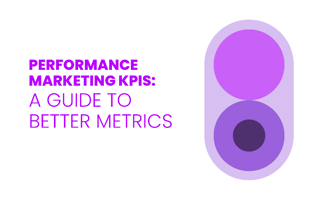Performance marketing relies on tracking and optimizing campaigns through measurable data, making...
Essential Components of a Winning Performance Marketing Strategy
Performance marketing is a results-driven approach to online marketing where businesses only pay for specific actions like clicks, leads, or purchases. This method stands apart from traditional marketing by ensuring that payment is based on outcomes rather than upfront costs.
By leveraging channels such as paid search, social media, and affiliate marketing, performance marketing allows businesses to precisely measure the impact of each campaign.
In this article, we explore the core factors that contribute to an effective performance marketing strategy, from setting clear goals to constant testing and iteration. These factors help businesses optimize their marketing efforts for maximum ROI.
For a simple overview of Performance Marketing, read "What is Performance Marketing? A Starter Guide."
What is performance marketing?
Performance marketing is a results-oriented marketing strategy where businesses pay based on actions taken by consumers, such as completing a purchase or signing up for a service.
Unlike traditional methods, which charge for ad placements or impressions regardless of the outcome, performance marketing ties costs directly to the success of the campaign.
The main advantage is that businesses can track every action and see exactly how much return they get for the money they spend. This makes it easier to optimize campaigns and focus on what brings in the best results.
![]()
Core Components of an Effective Performance Marketing Strategy
1. Set Clear and Measurable Goals
In performance marketing, setting clear and measurable goals means identifying specific outcomes you want to achieve, such as increasing website traffic or boosting sales.
These goals should be detailed, actionable, and tied to specific metrics that you can track and measure.
Importance
Clear and measurable goals help keep the strategy focused and allow for better decision-making. It ensures that every marketing effort is aligned toward achieving specific, trackable outcomes, improving efficiency and results.
Techniques
Define Key Performance Indicators (KPIs): Choose KPIs that are relevant to your marketing campaign, such as click-through rates or conversion rates, to track progress and success effectively.
Use SMART Criteria: Make sure goals are Specific, Measurable, Achievable, Relevant, and Time-bound, which helps in creating realistic and attainable targets.
Set Milestones: Break down large goals into smaller milestones to track progress over time, making it easier to stay on course and adjust strategies as needed.
2. Target Audience Identification and Segmentation
Target audience identification and segmentation involve identifying the specific group of people most likely to engage with your product or service and dividing them into smaller, meaningful segments based on factors like demographics, interests, or behaviors.
Importance
Identifying and segmenting your target audience ensures that your marketing message reaches the right people, increasing the likelihood of conversions. It also allows for more efficient ad spend by focusing on the audience most likely to engage.
Techniques
Use Data Analytics: Leverage tools like Google Analytics or social media insights to analyze user data and identify patterns that reveal who your most engaged audience is.
Create Buyer Personas: Develop detailed profiles of your ideal customers, including their age, interests, location, and pain points, to better understand their needs and tailor marketing messages accordingly.
Behavioral Segmentation: Segment your audience based on how they interact with your brand, such as frequent buyers or website visitors, to send targeted messages to different groups based on their behaviors.
3. Channel Selection and Diversification
Channel selection and diversification involve choosing the most effective Performance marketing channels to reach your target audience, like search engines, social media, or email marketing, and ensuring you don’t rely on just one channel.
Using multiple channels spreads risk and increases the chances of reaching potential customers where they spend their time online.
Importance
By selecting the right channels and diversifying, you increase the visibility of your brand across various platforms, improving engagement and reducing dependency on any single channel. This maximizes reach and enhances overall campaign performance.
Techniques
Analyze Audience Behavior: Understand where your target audience spends time online (e.g., social media, search engines) to select the most relevant channels for your marketing efforts.
Test Multiple Channels: Start with a few channels and test which performs best for your goals, then expand into other platforms to avoid relying too much on a single source.
Allocate Budget Wisely: Diversify your marketing budget across multiple channels based on their performance to ensure you’re investing in platforms that bring the best results without overspending on any single channel.
![]()
4. Data-Driven Optimization
Data-driven optimization is the process of continuously analyzing performance metrics and using insights to make informed decisions and adjustments to your marketing strategies.
It helps improve campaign effectiveness by focusing on what works and eliminating what doesn’t.
Importance
Data-driven optimization ensures that your marketing efforts are constantly improving and aligned with actual results, leading to better efficiency, higher ROI, and more targeted campaigns over time.
Techniques
A/B Testing: Test different versions of ads, landing pages, or content to see which performs better, and use the results to refine your strategy.
Monitor Key Metrics: Track key performance indicators (KPIs) like conversion rates, cost-per-click (CPC), or engagement rates, and adjust campaigns based on real-time performance data.
Use Predictive Analytics: Leverage tools that analyze past data to predict future trends, helping you anticipate changes and optimize campaigns before performance declines.
5. Creative and Compelling Ad Content
Creative and compelling ad content refers to designing visually appealing and engaging advertisements that grab attention and resonate with your audience. The content should communicate your message, evoke emotions, and motivate the audience to take action.
Importance
Effective ad content is crucial for standing out in a crowded market. Creative and engaging ads not only capture attention but also improve click-through rates and conversions, making them a core factor in the success of a performance marketing strategy.
Techniques
Focus on Strong Visuals: Use high-quality images or videos that represent your brand and product in a way that is visually appealing and catches the audience's attention immediately.
Craft a Clear Call to Action (CTA): Ensure your ad includes a strong, actionable CTA that tells the audience exactly what to do next, whether it's "Shop Now" or "Learn More."
Personalize the Message: Tailor your ad content to specific audience segments, addressing their pain points or desires to make the content feel more relevant and persuasive.
6. Effective Budget Management
Effective budget management involves planning, allocating, and optimizing your marketing budget to ensure that resources are used efficiently across different channels.
It helps maximize the return on investment (ROI) by focusing spending on the strategies and channels that deliver the best results.
Importance
Proper budget management is crucial to avoid overspending or underspending on marketing efforts. It ensures that funds are allocated strategically, leading to higher performance and better outcomes without wasting resources.
Techniques
Allocate Budget Based on Performance: Regularly review the performance of each channel and adjust your budget to invest more in high-performing areas and reduce spending in low-performing ones.
Set Flexible Budgets: Create a flexible budget that can be adjusted based on real-time data and changing market conditions, allowing you to seize new opportunities or pivot when needed.
Use Automated Bidding Strategies: Leverage automated bidding tools in platforms like Google Ads to optimize ad spend based on performance, ensuring that your budget is used efficiently to maximize results.
![]()
7. Tracking and Attribution Models
Tracking and attribution models refer to methods used to monitor user interactions with your performance marketing campaigns and determine which touchpoints (ads, emails, etc.) are responsible for driving conversions. These models help identify the channels and strategies that contribute the most to your success.
Importance
Accurate tracking and attribution models are essential for understanding the customer journey and optimizing marketing spend. They allow you to attribute conversions to the right channels, ensuring resources are invested where they have the most impact.
Techniques
Use Multi-Touch Attribution: This model gives credit to multiple touchpoints along the customer journey, helping you understand how different channels work together to drive conversions.
Implement UTM Parameters: Add UTM codes to your URLs to track the performance of specific campaigns and channels, making it easier to see where traffic and conversions are coming from.
Leverage Marketing Automation Tools: Use tools like Google Analytics or CRM systems that offer built-in tracking and attribution models to automate the process and gain detailed insights into how different touchpoints contribute to conversions.
8. Constant Testing and Iteration
Constant testing and iteration involve regularly experimenting with different elements of your Performance marketing campaigns (such as ad copy, images, or targeting strategies) and using the results to make continuous improvements.
This process ensures that your campaigns stay optimized and evolve with changing audience behaviors.
Importance
By continually testing and refining strategies, businesses can maximize their marketing efficiency. Constant iteration helps identify what works best, eliminating ineffective tactics and boosting overall campaign performance.
Techniques
Conduct A/B Testing: Run A/B tests on different versions of ads or landing pages to compare their performance and learn which elements are more effective in driving engagement and conversions.
Analyze Data Regularly: Monitor performance data frequently to spot trends and areas for improvement. Make adjustments based on real-time results to optimize ongoing campaigns.
Test New Ideas Gradually: Implement new strategies or creative ideas on a small scale first, measure their impact, and then roll out successful changes across larger campaigns to minimize risk.
Tools like 180ops help businesses optimize their performance marketing strategies by providing actionable insights that align marketing efforts with measurable revenue goals.
Conclusion
Performance marketing provides businesses with an effective way to optimize their marketing spend. By setting clear goals, identifying target audiences, diversifying channels, and using data-driven strategies, companies can refine their marketing efforts and achieve better outcomes.
Continuous testing and iteration ensure campaigns remain relevant and effective, while smart budget management and tracking help maximize ROI. With the right strategies, performance marketing enables businesses to reach their audience with precision and impact.
FAQ
What is the importance of setting clear and measurable goals in performance marketing?
Clear and measurable goals ensure your strategy stays focused and results-driven, allowing you to track progress and optimize efforts effectively.
How does identifying and segmenting your target audience improve performance marketing?
Audience identification and segmentation help tailor your message to the right people, increasing engagement and conversions while optimizing ad spend.
Why is channel diversification important in performance marketing?
Channel diversification spreads risk, increases visibility across platforms, and improves campaign reach by engaging with audiences on multiple channels.
How does data-driven optimization benefit performance marketing?
Data-driven optimization allows you to refine your strategy based on real-time performance metrics, ensuring continuous improvement and higher ROI.
What role does creative ad content play in performance marketing success?
Compelling ad content captures attention and motivates action, boosting click-through rates and conversions, essential for a successful campaign.




